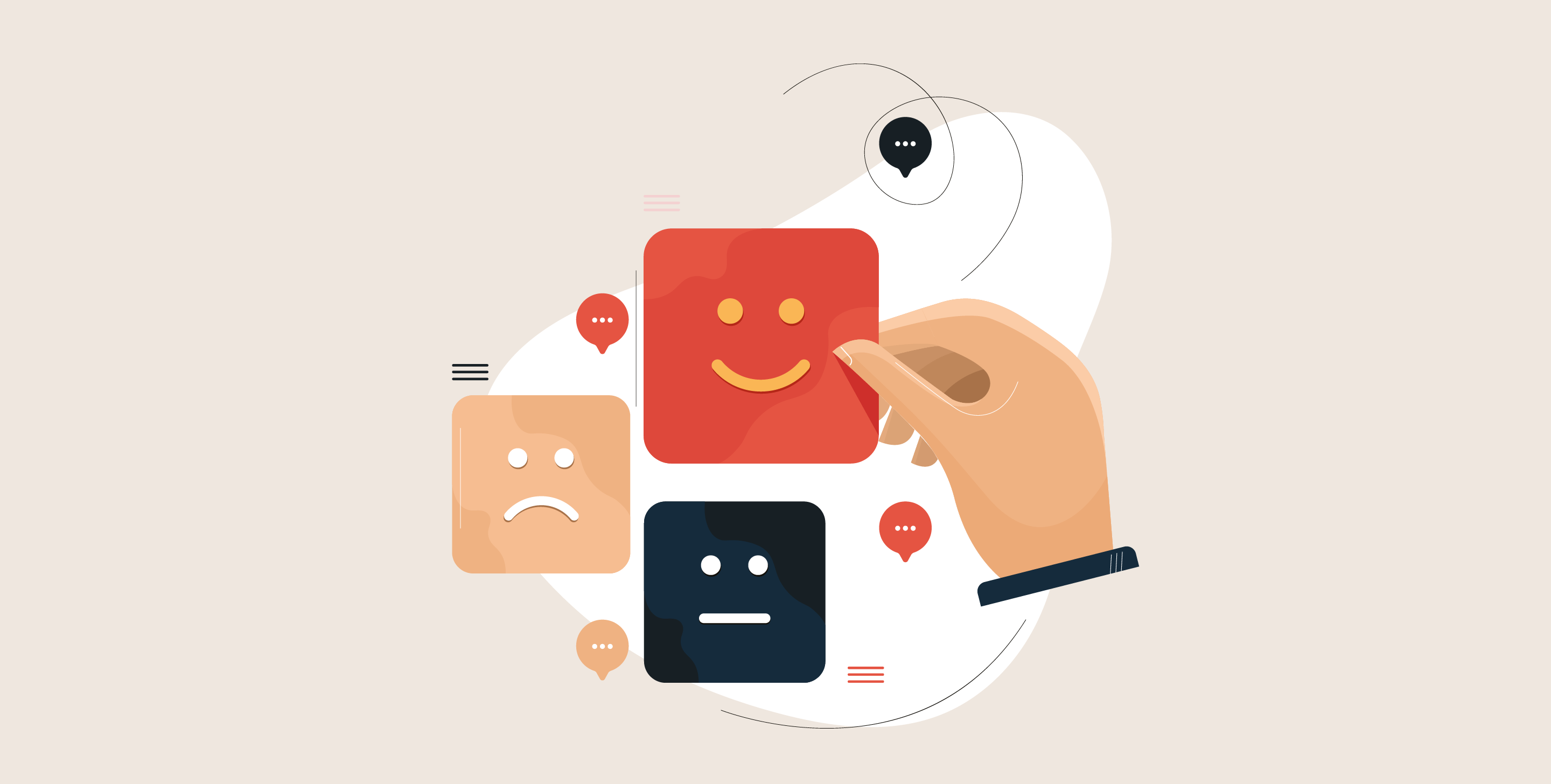Customer Experience
Customer Expectations: A Mini Guide for Beginners
Article written by Nishanth P K
Sr. Growth Marketer at SurveySparrow.
10 min read
19 September 2025

Customer expectations change with time. So, it’s vital to stay informed. If you are here to learn what customer expectations are and how you can meet them, then you are at the right place.
What Are Customer Expectations?
In simple terms, customer expectation is what a customer believes they will receive from a product/service.
For example, if you market your product as an all-in-one marketing tool, then customers would expect the tool to deliver exactly that. You will meet their expectations if your tool provides what you said. At the same time, failing to do so results in bad customer experience and thereby churn.
5 Different Types of Customer Expectations
Customer expectations can be differentiated based on the aspects of customer interactions. The following are the five types you should know about.

1. Explicit Expectations
It's clear from the name itself. There are clear and specific requirements customers say they want.
For example, a business will expect timely delivery of software updates as outlined in the service agreement. If the updates aren't on time, it would mean their expectations are not met.
2. Implicit Expectations
These are the unspoken assumptions customers have based on what they usually experience.
Suppose you purchased high-end software for, say, marketing purposes. But purchasing isn't the end. You know their team has to give you proper training and support. This is what implicit expectation looks like.
3. Interpersonal Expectations
These are expectations your customers have on how the staff will be treating them. Let's take a call center for example. Customers expect the support team to be polite and helpful.
4. Digital Expectations
Yes, you thought right....these are related to online experiences and interactions.
When shopping online, you expect the website to be easy to navigate and for your order confirmation to arrive quickly via email. If the site is confusing or the email takes too long, it can be frustrating.
Related Read: Digital Marketing Questionnaire For Onboarding Clients.
5. Dynamic Performance Expectations
Change is natural, and with time customer expectations will too. This is what dynamic performance expectations are.
For example, advancement in technology is a constant. Therefore, companies will expect the software they use to improve functionality and user-friendliness.
Now let's look at how customer expectations changed over time.
How Have Consumer Expectations Changed Over the Year?
If you ask us, there have been significant changes in customer expectations. There are many elements that customers prefer, but personalization stands tall among them.
In fact, about 77% of customers expect a more personalized experience from brands. This rise demands points towards their need for relevant and genuine connection with brands. So, those brands that favor personalization are likely to be successful in the current market.
So, the next question is how to meet this expectation.
Customer Engagement is the first step towards personalization. Moreover, 80% of the customers are likely to make a purchase if they feel recognized and understood. All the more reason for you to consider implementing personalization strategies.
Understand the key touchpoints and use AI chatbots to engage with customers. Make sure the chatbot is dynamic and responsive to customer queries. Not to mention offer helpful solutions to all customer queries.
Now let's see how you can manage the expectation effectively.
How Can You Manage Customer Expectations?
The only way to manage expectations is to understand your customers. For that, one of the best ways is conducting targeted surveys. This is the case, especially when you have B2B clients.
So, how to manage these expectations? Read on.
1. Customer Satisfaction Surveys
One of the most effective ways to stay connected with your customers is by conducting regular satisfaction surveys. Think of these surveys as a way to keep the conversation going. They provide you with real-time insights into how your customers are feeling and what they truly need.
We recommend conducting surveys at a regular interval, like quarterly or half-yearly. Sharing surveys after crucial interactions like resolving an issue can also be helpful. This way, you can focus on key areas such as service quality and product performance.
Pro Tip 💡:
Try using online survey tools like SurveySparrow. You can create and share surveys with ease and across various channels including WhatsApp. Be it NPS, CSAT, or In-app feedback, whatever your requirements are, SurveySparrow can be the solution.
The AI-powered survey creator and data analysis further make the tool more ideal for clearly understanding customer needs and expectations.

Create Your Customer Expectation Using AI!
A personalized walkthrough by our experts. No strings attached!
2. Ask the Right Set of Questions
When it comes to crafting your survey questions, aim for a mix of quantitative and qualitative questions.
For instance, asking customers to rate their satisfaction on a scale from 1 to 10 gives you a clear benchmark. But don’t stop there. You should include open-ended questions that invite them to share their thoughts.
Questions like, “What improvements would make our product even better for you?” can lead to valuable insights that numbers alone might miss.
3. Analyze Gathered Data
Once you gather this feedback, take the time to analyze it carefully. Look for trends and areas that need attention. We’ve found that creating simple reports highlighting key findings can really help drive action within your team.
For example, if multiple customers mention slow response times, it’s crucial to address this quickly by revamping your support protocols.
4. Communicate What You Found
Transparency is key in this process. After conducting surveys, make it a point to share the results with your customers.
Let them know what changes you plan to implement based on their feedback. This not only builds trust but also shows that you genuinely value their input.
Following up with another survey after making changes can help you gauge the effectiveness of your actions and refine your approach even further.
5. Continuous Analysis & Performance Tracking
It’s also wise to keep an eye on what your competitors are doing well in terms of customer service and engagement. This doesn’t mean copying them but rather using their successes as benchmarks for your own offerings.
For instance, if you notice that competitors are providing faster response times through chat support, consider enhancing your own chat capabilities.
Plus, there are many competitor analysis tools you can use for various use cases.
6. Implement Feedback Loop System
Creating ongoing feedback loops is another strategy we highly recommend. Establishing a system where feedback is continuously collected allows you to stay in tune with your customers’ needs.
Regular check-ins with key accounts or automated feedback requests after significant interactions can be incredibly beneficial.
7. Train Your Employees
Ultimately it will be your employees who will be connecting with the customers. So, it's important to train them on how to interact with customers. Let them know about the importance they play in your company.
Equip your employees with the essential tools and prepare them to effectively respond to customer feedback.
Go the extra mile and empower the employees to handle difficult conversations and train them to recognize customer cues. These skills can make all the difference in creating a positive customer experience.
Related Read: How to reply to negative feedback.
5 Factors Influencing Customer Expectations
The obvious question in your mind will be how exactly does a customer form expectations, right? We know this because it's our duty to understand our customers and this was the first we asked ourselves.
We did some digging, and guess what, we found some key factors that influence customer expectations. Let's have a look at them.

1. Previous Experiences
How the customers have been treated in the past is a significant factor that defines their expectations. These past experiences set a quality bar in customers' minds. So, they will naturally expect the same level of service in the future.
If they have a positive experience during the initial stage, they will expect the same throughout their journey. Similarly, if the experience is negative they will set a low bar of expectations.
Say for example, your client received exceptional support during a previous project. In this case, the client will anticipate the same kind of attention and care in the future as well.
2. Marketing and Communications
Your marketing materials can create a certain perception about your brand in customers' minds. What you have to do here is to be honest. Be clear, honest, and consistent with your messaging. This will help set realistic expectations.
If you market promises of outstanding service or innovative products, customers will expect nothing less.
3. Online Reviews & Word of Mouth
What would you do if you want to buy a new phone? You go online, maybe an online shop like Amazon, then filter out the phones with 4+ customer ratings. because that's how important you value the review of previous buyers. Similar is the case here.
Customers heavily rely on the opinions and experiences of those who have tried out your product/service. Positive feedback can elevate expectations significantly, while negative reviews can lead to skepticism.
For example, suppose the customer reviews of your product lauds the performance. Now, whoever is purchasing your product will have higher expectations of performance.
Related Read: How to manage Google reviews the easy way.
4. Industry Benchmarks
Let's not forget about your competitors. Your customers will always be comparing your offerings with that of your competitors. So, it's crucial for you to constantly check how your competition is doing things.
As the saying goes - "Keep enemies closer".
If your competitors are providing faster shipping or more flexible return policies, which, by the way, are important for eCommerce business, then try to incorporate them. You can never truly know anything. Such offerings could become the baseline for what customers expect from your business as well.
Staying aware of these benchmarks can help you meet or exceed customer expectations.
5. Cultural & Demographic Factors
Customers are not the same across the world. With place and the culture their needs and expectations change. This is why cultural norms and demographic differences play a key role in shaping expectations.
Different age groups may have varying preferences for technology use or communication styles. Take the initiative to understand these nuances. Why? Because this could allow you to tailor the offerings more effectively.
For example, in the case of customer support, Gen Z and Millennials would prefer quicker communication and resolution. This can be through help articles or chatbots. At the same time, older audiences, baby boomers and Gen X, would prefer good old phone support.
We hope you got the gist.
SurveySparrow to Help You Meet Customer Expectations

We already discussed how surveys can be the best way to understand customer preferences and needs. By understanding these, you can optimize your business to meet customer expectations.
Here's why SurveySparrow is the best survey tool for this purpose.
- Omnichannel survey distribution, helping you reach customers where they are.
- Multilingual surveys can help you reach a global audience.
- AI-powered analytics can provide you with deeper and more granular customer insights.
- AI survey feature can help you create surveys from scratch in seconds.
- Real-time analysis and reporting ability help you spot trends and areas of improvement instantly.
- Robust integration capabilities with tools like PowerBI, HubSpot, Salesforce, etc., makes it adaptable to any tech stack.
The list goes on. If you are interested in learning more about your customers, then try SurveySparrow. The free forever plan can be helpful in understanding how efficient and effective the tool can be.
You can sign up to try it out or connect with our team for a personalized demo!
14-day free trial • Cancel Anytime • No Credit Card Required • No Strings Attached

Make your customers feel heard. Turn feedback into loyalty with SurveySparrow's CX platform.
Nishanth P K
Growth Marketer with flair for experience management. Aspiring author.
Related Articles

Customer Experience
What Is Customer Service? How To Use It to Improve Customer Satisfaction?
17 MINUTES
5 April 2021

Customer Experience
Ecommerce CX Software: The Complete 2025 Guide
19 MINUTES
27 November 2025

Customer Experience
Top 11 Customer Experience Management Tools & Platforms
19 MINUTES
24 July 2023

Customer Experience
12 Tips For Exceptional Omnichannel Customer Experience
16 MINUTES
22 June 2019
